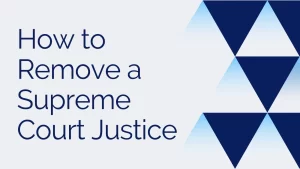Why do Supreme Court justices have lifetime appointments?
what is the term of office for supreme court justices? when can they be removed?
The lifetime tenure of U.S. Supreme Court justices has been ingrained since the founding of the country, but remains controversial. Article III of the Constitution states that judges “shall hold their offices during good behavior,” which has been interpreted to mean appointments for life. Defenders argue this protects justices from political pressures, while critics contend it makes the court undemocratic and unaccountable. As debates over ideological judging intensify, some reformers advocate for term limits or mandatory retirement ages. There are reasonable arguments on both sides, but changes to lifetime tenure should balance judicial independence and public accountability.
History of Why Are Supreme Court Justices Appointed For Life?
Framers’ Original Intent
The Framers deliberately empowered federal judges with lifetime appointments to maximize judicial independence from the political branches of government. After witnessing first-hand the colonies’ struggles with interference from English royalty, they sought to avoid partisan pressures influencing the court’s rulings.
Insulate Justices from Political Pressures
Lifetime appointments were intended to shield justices from worrying about currying favor with politicians or the changing opinions of the public. This liberates them to make decisions based on their best understanding of the law and Constitution.
Promote Judicial Independence
With their livelihood secure, justices can issue rulings that may be unpopular but necessary to uphold constitutional principles. Lifetime tenure gives them latitude to act as impartial referees detached from partisan influences.
Pros of lifetime tenure
- Insulation from partisan politics
- More consistency in jurisprudence
- Attracts experienced judges willing to make long-term commitment
Cons of lifetime tenure
- No public accountability after confirmation
- Irreversible poor appointments
- Lifespans lead to fewer court openings
why do supreme court justices serve for life
Arguments For Lifetime Tenure
Preserves Separation of Powers
Lifetime tenure helps safeguard the Supreme Court from political encroachment and maintains the separation of powers. The executive and legislative branches are directly accountable to voters, while the judiciary derives its legitimacy from remaining independent and nonpartisan.
Insulates Justices from Partisan Politics
If justices had to consider their reappointment chances or pension benefits, it could skew their rulings toward partisan leanings to satisfy political gatekeepers. The current no-strings-attached tenure frees them up to decide cases strictly on legal and constitutional grounds without trying to appease ideology-minded constituencies.
Arguments Against Lifetime Appointments
Undemocratic and Difficult to Amend
Critics contend that unelected justices serving extended terms wielding vast power over American life is fundamentally undemocratic. And the arduous constitutional amendment process makes it practically impossible to change Article III’s “good behavior” clause.
Increased Politicization of the Court
The high stakes over each Supreme Court vacancy raises the temperature of political conflict and accusations of judicial activism. Presidents often pick younger nominees to extend their legacy, which can lead to excessively long tenures advancing partisan agendas.
Proposed Alternatives and Reforms
Term Limits for Justices
Some reform advocates have proposed non-renewable 18-year term limits for justices. This would allow every President to nominate two justices per elected term, instilling a regularized process. It also reduces the enormous impact of any single appointee over multiple decades.
Supreme Court Retirement Age
Another idea is instituting a mandatory retirement age for justices such as 70 or 75 years old, which would effectively establish a tenure period of 20-30 years in most cases. This balances adequate job security without the outlier scenarios of justices staying on into extreme old age.
Supermajority Voting Requirements
Bipartisan judicial legitimacy could be buttressed by requiring 7-2 supermajority decisions to invalidate federal laws on constitutional grounds. This might restrain ideological rulings not firmly grounded in impartial legal analysis.
Removal of Supreme Court Justices
Impeachment process
The only way for a Supreme Court justice to involuntarily leave the bench is through impeachment by Congress, on grounds of “Treason, Bribery, or other high Crimes and Misdemeanors.”
House investigation and articles of impeachment
Impeachment proceedings begin in the House Judiciary Committee. If the Committee finds sufficient evidence of impeachable acts, it refers one or more articles of impeachment to the full House. A majority House vote is needed to impeach.
Senate trial and vote
If the House votes to impeach, the Senate conducts a trial presided over by the Chief Justice. A two-thirds Senate vote is required to convict and remove the justice.
Other ways a justice’s service can end
Voluntary retirement
Justices may retire of their own volition. The average retirement age is 78.7 years old. Many aim to retire under a politically sympathetic president.
Death
Lifetime service means most justices serve until they pass away. Since 1789 the average length of service is 16.6 years.
Conclusion
There are good-faith arguments on both sides of altering lifetime tenure for Supreme Court justices. Reform proponents make reasonable points about periodically refreshing the Court to align with current public opinion. However, there are also dangers in undermining the steadfastness of judicial independence. As the debate continues, we should thoughtfully assess these trade-offs rather than merely reacting to controversies du jour or temporary partisan grievances. Above all, preserving institutional legitimacy through fair-minded and legally sound judgments should remain the Court’s north star guiding important policy decisions.
FAQs
Why did the Framers give Supreme Court justices lifetime appointments?
The Framers intentionally gave justices lifetime tenure to shield them from political pressures when deciding cases so they could objectively rule based on the Constitution, regardless of popularity. This promoted judicial independence and the separation of powers.
What are the main arguments for lifetime appointments?
Defenders argue lifetime tenure preserves judicial independence, avoids incentives for justices to court political favors, enables unpopular but necessary rulings, and maintains separation of powers between branches of government.
What reform ideas have been proposed as alternatives?
Ideas proposed include: 18-year term limits to regularly refresh the Court, mandatory retirement ages between 70-75, and requiring 7-2 supermajority decisions to overturn federal laws.
Would term limits reduce politicization of the nomination process?
Term limits could actually raise the stakes of nominations further by making vacancies even more frequent and predictable. But they may still be worth considering to reduce prolonged ideological influence.
Could lifetime tenure be changed by constitutional amendment?
Yes, but the arduous multi-step amendment process prescribed in Article V makes any changes extremely difficult to enact in reality.
What is the term length for a Supreme Court justice?
Supreme Court justices receive lifetime appointments, so there is no fixed term length. Justices serve until they resign, retire, pass away, or are removed from office through the impeachment process.
Can a justice be fired?
Supreme Court justices cannot be fired from their lifetime appointments. The only way to involuntarily remove them is through congressional impeachment proceedings on grounds of “Treason, Bribery, or other high Crimes and Misdemeanors.”
How often do vacancies open up on the Court?
On average a Supreme Court vacancy has occurred once every 2 years throughout history. Vacancies open up when justices resign, retire, or die in office, which most aim to times to occur under a favorable president.
Do Supreme Court justices have term limits?
No, Supreme Court justices do not have term limits. They receive lifetime appointments upon confirmation by the Senate. After being appointed they can serve for the remainder of their lives if they choose.
Can a Supreme Court justice be re-appointed?
Because Supreme Court justices already have lifetime tenure, there is no need for them to ever be re-appointed. After being confirmed once by the Senate, they can serve on the Court for as long as they want without needing any further confirmation or approval.








